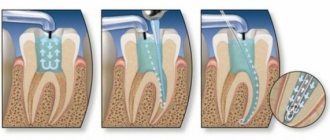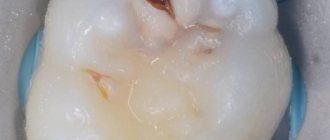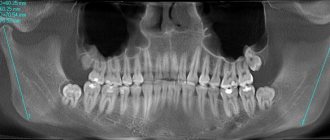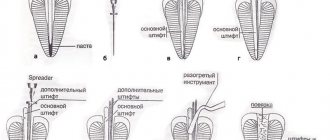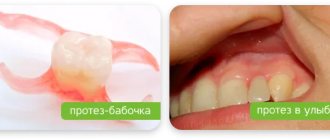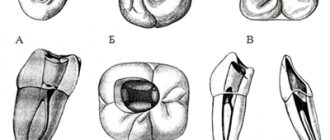Canal unsealing is a dental procedure that is aimed at removing a previously installed filling. Another name for it is “disobturation”. The process requires expansion of the canals in the direction from the crown to the apex of the root for the purpose of high-quality cleaning of dental cavities. The procedure is resorted to after endodontic treatment carried out with violations of technology. It must be carried out on time, since infectious agents that have penetrated the dental tissues will provoke the development of inflammatory processes, which, in turn, can cause the loss of the entire tooth.
The therapeutic department of dentistry CELT invites you to undergo root canal retreatment in Moscow. Our clinic is multidisciplinary and has been offering paid medical services for more than two decades. Our dental therapists have a modern diagnostic and treatment base in their arsenal, thanks to which they are able to accurately and promptly make diagnoses and carry out treatment in accordance with international standards. You can find out the approximate price for unsealing canals by going to the “Services and Prices” tab. We regularly update the price list, but in order to avoid misunderstandings, we recommend that you check the exact numbers with our operators or at a doctor’s appointment.
Consultation with a dentist-therapist - 1,000 rubles.
Unsealing a previously obstructed canal (1 canal) - RUB 3,000.
Unsealing the canal under the stump tab - 1,700 rubles.
At CELT you can get advice from a dental specialist.
- The cost of a consultation with a dentist-therapist is 1,000
Make an appointment
Indications and contraindications for root canal filling
Indications
- Painful symptoms, inflammatory processes and swelling of the gum tissue in a patient who some time ago underwent endodontic treatment;
- Insufficient quality of the filling is its depressurization or poor fit at the edges, which makes it difficult to remove food debris and provokes the development of a carious process;
- Inflammatory or infectious processes of the dental canals under the filling;
- The need for retreatment of root canals for pulpitis, periodontitis, cystic formation, granuloma;
- The need to install an intracanal pin;
- Violations of the previously performed root canal obturation technology.
Contraindications
- Serious damage to the periodontal tissues surrounding the unit, which is not an obstacle to saving the tooth;
- The unit is unsuitable for restoration;
- Impossibility of intervention on its closed part;
- Neoplasm of malignant etiology in the area of the affected unit;
- A purulent-necrotic process that affects bone tissue;
- General serious condition of the patient.
Is it necessary to treat a tooth if it doesn’t hurt?
Sometimes re-treatment is required even if the patient does not feel any discomfort. For example, poor quality of work or filling material leads to the fact that one canal remains not completely closed. A chronic process develops, which the doctor detects on an x-ray. A chip, crack or complete loss of the filling is also a reason for infection. In these cases, retreatment should be carried out regardless of whether there is pain or not.
Features and stages of unfilling root canals using medication
Chemical deobturation is carried out using one of two methods:
- Moderate complexity - performed in one visit and indicated if you need to remove hardening pastes. The latter dissolve well with organic solvents and are easily removed using endodontic instruments. In this case, canal retreatment under a microscope is carried out in one visit to the dentist;
- High complexity - indicated if the canals were filled with cement or resorcinol-formalin paste, rarely required when treating patients with old fillings. A dissolving gel is instilled into the canal, and after the filling has softened, a special tool is inserted into it, which allows it to be removed by turning it clockwise and counterclockwise. The dentist must work very carefully so as not to damage the integrity of the canal walls or break the instrument. This type of filling requires two visits to the doctor.
Stages of chemical unsealing:
- Removing a surface filling with a dental bur;
- Applying solvent to old material;
- Careful removal of the filling material after it has softened;
- Removal of tissue affected by caries, treatment of other diseases;
- Re-filling of canals.
Retreatment of tooth canals under a microscope and x-ray
X-rays have long served faithfully in dentists' offices, allowing doctors to see the field of activity and track the steps of root canal treatment in real time. And today doctors are not going to abandon the X-ray examination procedure; this diagnosis will remain in demand for years to come. However, along with objective data, x-rays do not always provide the attending physician with a complete picture of the event.
Disadvantages of X-ray:
- Inaccurate photographs. This is possible when a patient is photographed with treated canals that were filled with non-contrast material. Then the image does not show all the areas that require re-treatment. In addition, x-rays do not show fluid in the canals.
- The procedure is prohibited for pregnant women and small children. Sometimes there is an urgent need to insert a tooth into the canal, but without an x-ray the doctor will have to work almost blindly.
- Irradiation of the patient. Of course, the X-ray machine emits microdoses of gamma rays, but sometimes the dentist is not clear where the canal goes. You have to photograph the tooth root from several sides and make a number of projections. Not wanting to expose the person to unnecessary radiation, the doctor stops the study, but the result may still be unsatisfactory.
X-ray works perfectly in tandem with a microscope. Root canal treatment using magnification greatly simplifies the work of the endodontist. By changing the direction of light and adjusting the sharpness, the doctor distinguishes the direction of even a complex and convoluted canal. Therefore, retreatment takes place as efficiently as possible, right up to the very top.
At the same time, the invasiveness of treatment is significantly reduced. The doctor, looking through a microscope, easily removes nerve tissue from the canals without damaging the walls or touching healthy tissue. It’s no secret: the more natural tissue that was preserved, the more favorable the treatment scenario.
It is incorrect to compare X-rays and microscopes. These are two complementary tools in the hands of an experienced doctor, allowing him to provide quality treatment in the interests of the patient. The microscope will help in the retreatment of tooth canals, in the elimination of carious processes, and is used in excluding other unpleasant diseases of the oral cavity.
If the device is available in the clinic, and doctors do not allow this expensive equipment to sit idle, the clinic clearly demonstrates a high level of treatment. Every person can imagine how much better and more conscientiously a doctor works if the affected area is well illuminated and enlarged. With such careful treatment, the risk of infection and relapse of inflammation is completely eliminated.
At the clinic of Dr. Lopaeva, the task of re-treatment of tooth canals is solved at the highest level. Our highly qualified endodontist dentists cure tooth canals once and for all. During all manipulations, healthy tissues are carefully preserved and strengthened, and damaged tissues are removed without pain or harm to health. Do not hesitate with the procedure; infected tooth tips can provoke serious complications, including the development of tumors.
Treatment of dental caries using the Icon method without preparation
Cervical caries on the front teeth: causes and treatment
Restoration of tooth enamel, price, drugs
Retreatment of tooth canals before prosthetics, with granuloma, cyst and aching pain
Root canal treatment for chronic periodontitis
Treat or remove wisdom tooth pulpitis
Dental treatment during pregnancy 2nd trimester
Reviews of doctors providing the service - root canal unfilling
I would like to express my gratitude to the dentist Elena Nikolaevna Kiseleva and her assistant Svetlana - they are real specialists and at the same time sensitive, not burnt out by years of practice.
Thanks to them, I have been coming back here for many years. Thanks to the management for such doctors! Read full review Svetlana Nikolaevna
13.08.2021
Words cannot express my gratitude to Elena Nikolaevna Kiseleva. This is the best doctor in the world. I got an appointment after many years of being ignored by the dentist’s office and with a bitter experience of treatment in another paid clinic, the mistakes of which had to be corrected in the first visits. Thank you for this... Read full review
Roman Stanislavovich Sh
25.07.2020
PROCEDURE
After the doctor informs the patient about the upcoming treatment, a step-by-step action plan will be drawn up:
- Opening or unfilling a diseased tooth - complete removal of old filling material from the carious cavity and canals;
- Treatment of inflammation and removal of affected tissue from the apical area, complete disinfection;
- Careful hermetic sealing of all cavities.
Treatment for inflammation depends on its cause. If an x-ray reveals a granuloma or cyst in the area of the root apex, it will be removed after opening the tooth.
The method of removing the inflammatory focus and disinfection after surgery will be chosen by the doctor, in accordance with the financial capabilities of the patient.
WHAT TYPES OF TREATMENT CAN BE OFFERED
Inflamed tissue can be removed using the Doctor smile D5 laser, if the patient is willing to pay the cost of this service. The laser beam completely disinfects the tissues affected by it. Or the operation will be performed using the endosurgical method: removal of the root apex. If this is no longer possible, a hemisection (removal of one of the roots of a multi-rooted tooth) will be performed.
For the purpose of sanitation, the open cavity and roots are treated with disinfectants. In a difficult case: with tortuous and difficult-to-pass canals, they are subjected to intracanal depophoresis, with preparations containing copper and calcium ions.
Then the tooth is carefully filled under the control of radiovisiography (X-ray machine), and only after making sure that there are no cavities left, it is closed with a temporary filling with a medicinal substance. If the tooth can withstand a hermetically sealed filling, no drainage of accumulated fluid is required, and a fistula tract does not appear, then a permanent filling is placed.
RESTORATION OF THE APPEARANCE AND CHEWING FUNCTION OF THE TOOTH
After all therapeutic measures are completed, the crown part of the tooth is restored using an inlay or other methods of microprosthetics. A crown can be placed on a cured tooth and it will last for many years.
If it is too late to see a doctor, the tooth is so damaged that it cannot be restored - it is removed. After removal, it is recommended to immediately proceed with prosthetics, since the absence of even one tooth can lead to further destruction of the rest due to their displacement and loosening.
Our DentaLux-M clinic has European equipment that meets the latest technological advances and qualified medical personnel. In treatment, we use tooth-preserving technologies, because “your” tooth is always better than an implant or removable denture. Prices in our Medical Center are average in the city. You can always make an appointment in advance.
Why is the procedure so effective?
With the right approach, the procedure allows you to save the tooth due to:
- removal of tissue affected by caries;
- no need for anesthesia;
- eliminating the symptoms of diseases that developed under the filling
The use of a microscope in the process significantly improves its quality, since it allows you to correctly assess the features of the anatomical structure and the condition of the root canals. It is worth noting that the cost of canal retreatment with their use is higher, however, the effectiveness of the procedure increases significantly.
Where to go?
Such a high-tech type of assistance, such as re-treatment of previously filled root canals, can only be offered by a few dental clinics in Moscow. And we are glad that ours is among them. The latest equipment and a team of experienced doctors who know advanced treatment methods help us provide modern services at a high level. The principle of our work: if a tooth can be saved, we need to use all methods to fight for it.
Causes of pain after retreatment
If a person has a toothache after canal retreatment, and the pain continues for a long time, this indicates a violation by the dentist during treatment of the technological process:
- A piece of dental instrument remains in the root canal.
- Insufficient pre-treatment of the dental canal, as a result of which its lumen was not fully expanded and infectious agents remained in it.
- The dentist incorrectly determined the depth of the canal being treated and the filling material did not completely fill it (voids remained) or went beyond the root.
- During cleaning, perforation (instrumental damage) of the wall of the dental canal occurred, but the dentist did not notice the problem and did not close the resulting through hole with an adhesive solution.
Removing the seal under the anchor pin
Obturation of the tooth root canal is done in parallel using anchor pins. If the filling in the lower part of the root is placed correctly and hermetically, then it is left to install the pin structure. This procedure is carried out over two trips to the dental office.
On the first day, the doctor treats the dental canal mechanically, softens the filling with medications and cleans the passage with an endo-instrument. The doctor then soaks a cotton swab in the medicine and inserts it into the canal. The patient takes the medicine for a couple of days and then makes another visit to the doctor, during which the cotton swab is removed and the canal is refilled.
Modern technologies in the field of tooth refilling
Dental treatment under a microscope is one of the newest services that has appeared in dentistry. High-tech equipment allows specialists to fill the dental canal with better quality, more accuracy and efficiency. Thanks to the use of such a device, the likelihood of causing harm to healthy tissue is close to zero. In addition, the treatment is carried out very delicately. Microscope glasses allow you to view the tooth at multiple zooms. This will allow you to see all the affected areas that may simply not be visible during normal examination.
A microscope allows dentists to perform root canal treatment faster and safer for the patient.
